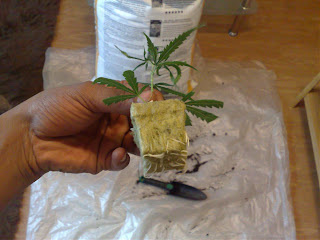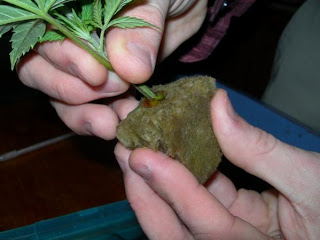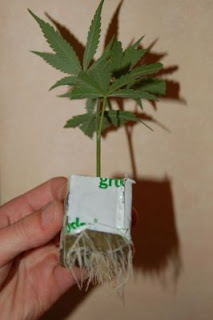What follows are step by step instructions for a simple procedure that works for most types of cannabis plants.
Choice of medium:
you can use many different mediums to clone marijuana:
Rockwool: Jiffy pellets:

Dirt: or even just water:


for this guide were gonna use rockwool, since i find it to be the easiest.
Rockwool:
Rockwool is a mixture of melted rock and sand that has been spun into thread and compressed into different shapes.
RETAINS WATER
Rockwool holds an incredible amount of water.
HOLDS AIR
Rockwool holds at least 18 % air at all times (unless it is sitting directly in water). This supplies the root zone with plenty of oxygen, making overwatering less likely.
COMES IN A VARIETY OF SIZES AND SHAPES
From 1" cubes designed for use in clone making, to huge slabs capable of holding the root systems of huge plants.
CLEAN AND CONVENIENT
Rockwool holds together very well so it can't spill. It also comes wrapped in plastic, making it easy to handle and keeping evaporation to a minimum.
Disadvantages to Rockwool
Just watch out for PH problems, cause Rockwool has a high pH which means you have to adjust your nutrient solution low so that the root zone is neutral. Rockwool is also susceptible to pH shifts meaning more routine maintenance to keep the pH levels correct.
Pre-soak the rockwool:
Wash out your Rockwool with clean water for a couple minutes (the water will get pretty dirty)
Then treat the rockwool by soaking overnite in a 1/4 strength nutrient solution.
Be sure check your PH, you want something around 6.5.
Prepare the clone:
When taking a cutting, always plan on having at least one node inside the hole, and 4 to 6 nodes above. My cuttings are about 2.5 to 3.5 inches tall plus approx another 1 inch below the surface. The stem width of my cuttings (at the cut) average 3/32 to 1/8+ inch.
1. Trim off the leaf/shoot that goes in the cube with a razor blade before taking the cutting (see above)
2. Make the diagonal cut on the stem (from the mom) about 1/4 inch below a node. Use a new razor blade with a small piece of wood behind the stem to serve as an anvil for making a clean cut.
3. IMMEDIATELY dip the bottom one inch of the cutting in the rooting liquid for about 15 to 30 seconds, tweaking it to dislodge any air bubbles that may be present.
4. Then gently push it into the hole (I usually use large tweezers to poke into the rockwool about 1/2 inch from each side of the cutting then squeeze the rockwool to hug the stem).
Leave the cube in a humidity dome at around 80 to 85 degrees F, with about 30-40 Watts/sq ft of fluorescent lighting on for 24 hours a day. Lift the dome at least once/day.
humidity dome
The first night the cuttings will droop, the second day they will start to lift their heads.
I've taken clones rooted in rockwool and transplanted them directly into a pot with soil with no problems at all.. that's the joy of rockwool, virtually no transplant shock from disturbed roots. As long as roots can be seen coming from the rockwool cube it can be transplanted.
How do you recommend supplying nutrients to the rooting stem?
Nutrition is not as much of a concern as moisture is.
The cube should NOT sit in water. As long as humidity is high, you can spray with the 6.5 pH solution twice a day for the first 2 days, then once a day until it roots. But the humidity must be high; you should see condensation inside on the tray walls and maybe the leaves. I also spray the walls of the tray to keep it humid. Spray only the leaves not the cubes.
Check for roots around the eighth day by opening a cube in half very carefully. White roots should be exiting the node.
Keep in mind that the longer you have humid conditions the more likely it is to get mold or fungus; rooting quickly is one way to avoid lengthy humid conditions.
Once rooted:
they should look somehting like this:
When you first see the cutting is rooting through the cube bottom, you can stop spraying and start watering the cube, let the solution drain from the cube.
This is a critical time:, when you see roots, water the cube and remove the dome to allow humidity to escape AND CHECK EVERY 20 MINUTES for ANY SIGN of wilting. If after the 1st hour with no wilting leave it of, and check every hour. After 4 to 6 hours with no wilting, you're ready to rock n roll. If any clones START to wilt put the dome back on, spray leaves, and try again the next day.
If you have some rooted, some not, go for the humidity for a couple more days.
Using General Hydroponic's 'Flora' nutrients and rockwool, and clonex, I root in 8 days with great looking clones. So there IS a difference in nutrients, medium, and rooting compounds. BTW use a fresh mix of nutrients, and keep the bottle sealed. pH can shift radically, but usually wont do so for the first 10 days if the bottle's kept sealed, out of light, and at room temperature. And don't forget HUMIDITY, HUMIDITY, HUMIDITY. But don't overdo it for too long or you risk mold and damping off.
if you still dont get it, here are some videos that explains it in detail (i didnt make these):








